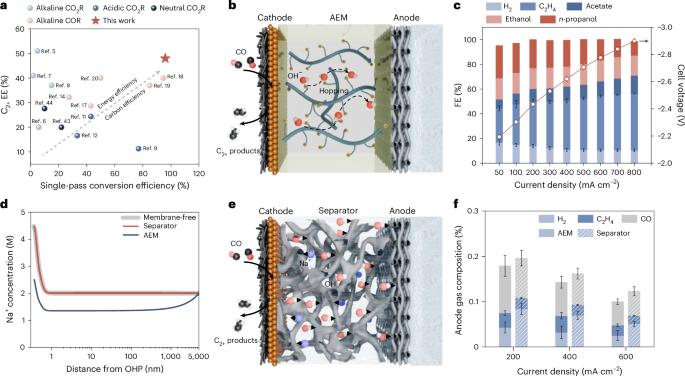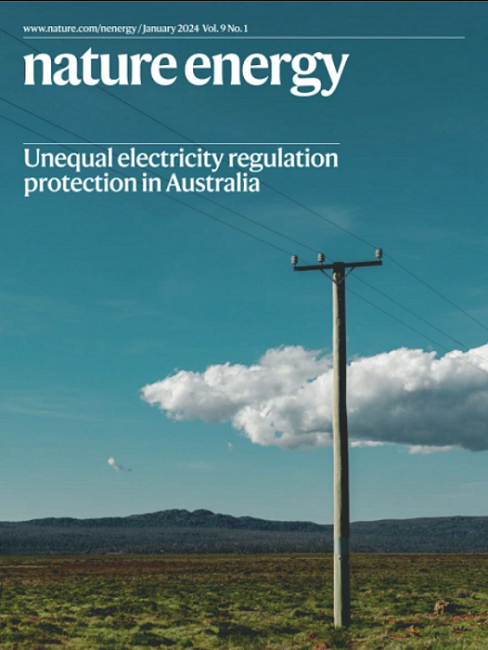采用多孔分离器的CO电解槽对C2+具有51%的能源效率
IF 60.1
1区 材料科学
Q1 ENERGY & FUELS
引用次数: 0
摘要
电化学CO2还原可以通过CO2- CO级联反应生成多碳(C2+)产物,然后进行CO还原(COR)。然而,由于电荷选择膜内离子传输缓慢,COR的能量效率仍然低于40%。在这里,我们介绍了一种不带电的多孔分离器,可以方便地传输两种离子类型,降低催化剂表面的欧姆电阻和超浓缩阳离子-在200 mA cm - 2下将COR电压降低150 mV。在以前的电解槽设计中,多孔分离器受到阴极到阳极H2交叉的限制;C2H4和CO在水中的低扩散率使得分离器的厚度减少了三倍,多孔性增加了1.6倍,显著降低了过电位。在高温下,镍铁基阳极进一步降低了330 mV的电压,在200 mA cm - 2下的全电池电压为1.95 V,对C2+产品的能量效率为51%,持续时间超过250小时。该系统还实现了97%的CO单次转化率和产品气流中C2H4浓度为87 wt%。低能量效率阻碍了电化学COx还原为多碳产物,部分原因是由于电解槽中使用的电荷选择膜上的离子传输缓慢。在这里,作者使用了一种多孔的、非电荷选择性的分离器,增强了离子传输,提高了CO电解的性能。本文章由计算机程序翻译,如有差异,请以英文原文为准。

CO electrolysers with 51% energy efficiency towards C2+ using porous separators
Electrochemical CO2 reduction can generate multi-carbon (C2+) products via a CO2-to-CO cascade followed by CO reduction (COR). However, COR energy efficiency remains below 40% due to sluggish ion transport within charge-selective membranes. Here we introduce an uncharged porous separator that enables facile transport of both ion types, reducing ohmic resistance and superconcentrating cations at the catalyst surface—lowering COR voltage by 150 mV at 200 mA cm−2. In previous electrolyser designs, porous separators were limited by cathode-to-anode H2 crossover; the low diffusivity of C2H4 and CO in water allows a separator three times thinner and 1.6 times more porous, markedly reducing overpotential. Operating at elevated temperatures with a nickel–iron-based anode further lowers voltage by 330 mV, leading to a full-cell voltage of 1.95 V at 200 mA cm−2 and an energy efficiency of 51% to C2+ products sustained over 250 h. The system also achieves a CO single-pass conversion of 97% and a C2H4 concentration of 87 wt% in the product gas stream. Electrochemical COx reduction to multi-carbon products is hindered by low energy efficiency, in part due to sluggish ion transport across charge-selective membranes used in electrolysers. Here the authors use a porous, non-charge-selective separator that enhances ion transport and improves performance for CO electrolysis.
求助全文
通过发布文献求助,成功后即可免费获取论文全文。
去求助
来源期刊

Nature Energy
Energy-Energy Engineering and Power Technology
CiteScore
75.10
自引率
1.10%
发文量
193
期刊介绍:
Nature Energy is a monthly, online-only journal committed to showcasing the most impactful research on energy, covering everything from its generation and distribution to the societal implications of energy technologies and policies.
With a focus on exploring all facets of the ongoing energy discourse, Nature Energy delves into topics such as energy generation, storage, distribution, management, and the societal impacts of energy technologies and policies. Emphasizing studies that push the boundaries of knowledge and contribute to the development of next-generation solutions, the journal serves as a platform for the exchange of ideas among stakeholders at the forefront of the energy sector.
Maintaining the hallmark standards of the Nature brand, Nature Energy boasts a dedicated team of professional editors, a rigorous peer-review process, meticulous copy-editing and production, rapid publication times, and editorial independence.
In addition to original research articles, Nature Energy also publishes a range of content types, including Comments, Perspectives, Reviews, News & Views, Features, and Correspondence, covering a diverse array of disciplines relevant to the field of energy.
 求助内容:
求助内容: 应助结果提醒方式:
应助结果提醒方式:


